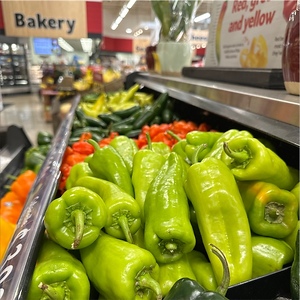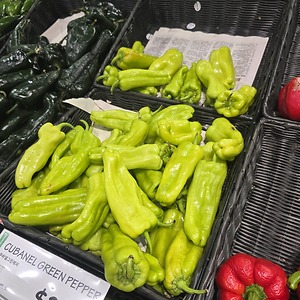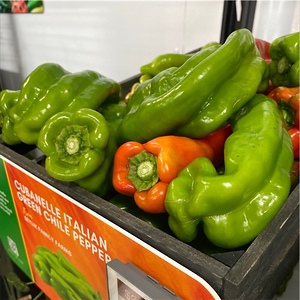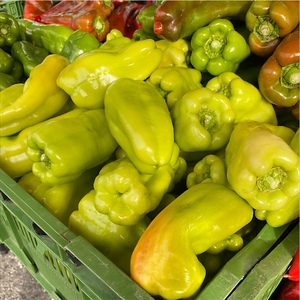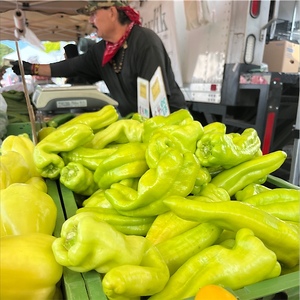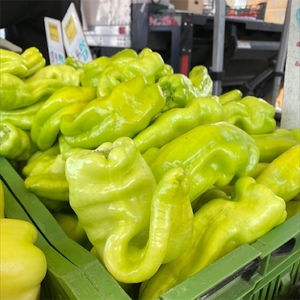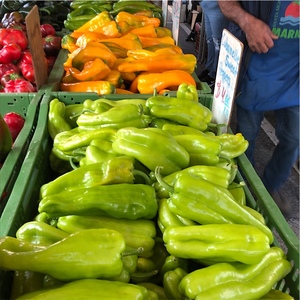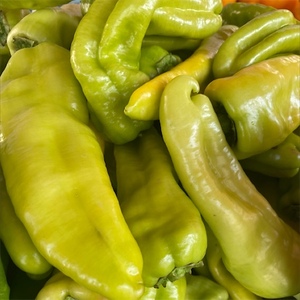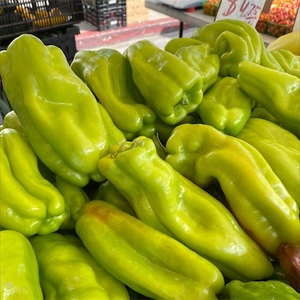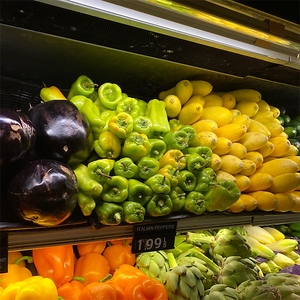

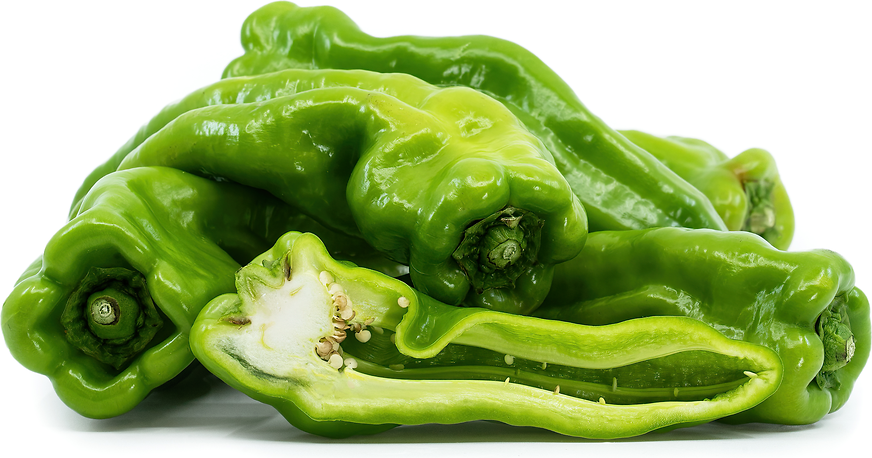
Cubanelle Italian Green Chile Peppers
Estimated Inventory, 10 lbs : 0
Description/Taste
Green Cubanelle peppers vary in size and appearance, depending on the climate in which they are grown, and generally average 10 to 15 centimeters in length and 5 to 7 centimeters in diameter. The pods have an elongated, tapered shape with blunt, curved ends and may appear creased, twisted, or straight. The skin is thin, smooth, firm, and glossy, showcasing shades of light to bright green, and has a taut, waxy feel with some wrinkles. Underneath the surface, the flesh is thin, lightly striated, pale green, and crisp, encasing a central cavity filled with a few round, flat, cream-colored seeds. The flesh has a lower water content than other varieties, allowing it to retain a pleasant crunchiness, even after cooking. Green Cubanelle peppers are edible raw and are known for their sweetness with fruity, nutty nuances. The variety is considered mild but does carry a very low heat to palates that are more sensitive to spice.
Seasons/Availability
Green Cubanelle peppers are available in the summer through fall.
Current Facts
Green Cubanelle peppers, botanically classified as Capsicum annuum, are young versions of a variety of sweet peppers belonging to the Solanaceae or nightshade family. Cubanelle peppers are favored for their mild heat, ranging from 100 to 1000 SHU on the Scoville Scale, and for their ability to absorb accompanying flavors while adding a subtle textural crunch to culinary dishes. The variety is sold in its immature green and mature red stages, commonly harvested around 65 to 80 days after sowing. Green Cubanelle peppers are picked early from the plant to retain a fresh flavor in the pods. Worldwide, Cubanelle peppers have found success as a culinary ingredient and are known by several regional names, including Cubanela, Ají Cubanela, Sweet Cubanelle, Cubanelles, Italianelles, Friarelli, and Italian Frying Peppers. The elongated pods cook quickly and are versatile for various raw and cooked dishes, making them popular for commercial production and home garden cultivation.
Nutritional Value
Green Cubanelle peppers are a source of vitamins A, C, B, and E to guard the cells against free radical damage, maintain healthy organs, strengthen the immune system, and aid in energy production. Cubanelle peppers also provide fiber to improve digestion and minerals like potassium, phosphorus, calcium, and magnesium. Potassium balances fluid levels within the body, phosphorus and calcium strengthen bones and teeth, and magnesium helps control nerve functions.
Applications
Green Cubanelle peppers have a sweet and subtly fruity taste suited for raw and cooked culinary preparations. The variety is distinct from other peppers as it has a sweet flavor, even when in its green stage, allowing it to be chopped into salads, layered into sandwiches, or served on appetizer platters with dips. Green Cubanelle peppers can also be chopped into salsa and relishes or used as a fresh topping over tacos and grain bowls. In addition to raw preparations, Green Cubanelle peppers are commonly added to soups and stews or cooked into sauces like mole. The peppers are also favored for their thin, fast-cooking walls, making them a popular frying pepper. Try stuffing Green Cubanelle peppers with rice and meat as a savory main or baking the pods into casseroles. The variety is also tossed into stir-fries, used as a pizza topping, or roasted whole as a simple side dish. In the Americas, Green Cubanelle peppers are an essential ingredient in Dominican, Puerto Rican, and Cuban cuisine. The peppers are also often incorporated into sofrito, a base of aromatic ingredients cooked together to form a foundational dish flavoring. In Naples, Italy, the sweet green peppers are cooked with tomatoes, garlic, and onion, while in Sicily, the peppers are baked with a pine nut and bread crumb stuffing. Green Cubanelle peppers pair well with meats such as chorizo, turkey, beef, and poultry, aromatics like onions, garlic, and ginger, herbs such as basil, cilantro, and thyme, and spices such as cumin, cloves, cinnamon, and paprika. Whole, unwashed peppers will keep for one week when loosely stored in a plastic or paper bag in the refrigerator.
Ethnic/Cultural Info
In the Marche region of Italy, whole Green Cubanelle peppers are traditionally pickled between layers of grape pomace. The recipe is thought to have arisen from villages near the province of Pesaro and is a tradition primarily localized to that region, according to Daniel Pambianchi on his site “Techniques in Home Winemaking.” Grape pomace is the discarded grape skins and seeds extracted during the winemaking process. This mixture is added to a container, and Green Cubanelle peppers are layered and covered with grape skins. The peppers are left for at least 4 to 6 weeks to develop their distinct, fermented taste. Once ready, the peppers can be eaten as a condiment or snack or served on a fresh baguette with salt and olive oil. They can also be added to sandwiches or eaten with olives and onions.
Geography/History
Green Cubanelle peppers are descendants of ancient pepper species native to South and Central America that have been growing wild for centuries. The early pepper types were eventually selected for cultivation among Indigenous populations, and new varieties were bred over time for improved characteristics. Peppers were taken from the Americas to Europe by Spanish and Portuguese explorers during the 15th and 16th centuries, and they were eventually planted throughout Italy. The exact history of Green Cubanelle peppers is unknown, but the variety later became established throughout Central America and the Caribbean, specifically in Cuba, the Dominican Republic, and Puerto Rico. They were also introduced to the United States. Today, Green Cubanelle peppers are commercially cultivated and are also planted in home gardens. When in season, the variety is sold through fresh markets, select wholesalers, and retailers.
Recipe Ideas
Recipes that include Cubanelle Italian Green Chile Peppers. One



